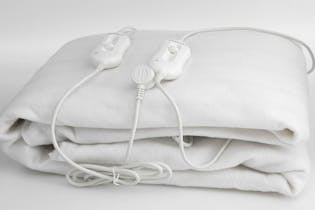Electric blankets
Choose the right electric blanket this winter and learn how to use and store it safely.
Dreading the thought of getting into a cold bed tonight? An electric blanket could be the solution.
Choosing a blanket
Our test found minimal difference in heating performance between the most expensive and cheapest blankets. So the question is why anyone would spend more than $100 on an electric blanket? The answer is extra features.
Models costing upwards of $200 generally offer all-night and timer settings, which automatically switch off the blanket after a set period (from one to 12 hours depending on the model), and they often feature a wool fleece cover. We recommend against leaving an electric blanket on all night, but if you do ensure you use the timer and an all-night setting.
Many high-end blankets also offer foot and body zones, allowing separate temperature control of these areas. Perfect if you want extra toasty feet, or are one of those people that likes a warm top but cooler bottom.
But if you don’t want all these bells and whistles, then there’s no reason to shell out more than $100 for an electric blanket. Our cheaper models are also great options for replacing an aging blanket in guest rooms.
Running costs
Power ratings of electric blankets range from 50 watts to 150 watts (per side), so they are actually relatively cheap to run. If you only use your blanket to preheat your bed and turn it off when you get in, it will cost around $1.50 per winter (for a queen sized blanket). If you have a blanket that can be left on overnight, the cost will go up from around $4 per winter, to nearly $30 per winter for one of our more power hungry tested models.
Could your next power bill be smaller?
Powerswitch is the free, independent way to check your power plan, and see if you could save - backed by Consumer NZ. So why pay more than you need to? Check in just 3 minutes - and make sure you know the deal.
Safe use
According to a Fire Service spokesperson, electric blankets caused 11 fires between July 2015 and June 2016. They said the most common cause was electrical failure or malfunction, which emphasises the importance of getting a blanket checked by a qualified electrician if you have any doubts over its safety, or if it’s more than five years old. We think any blanket older than five years should be tested or replaced.
Before fitting the blanket:
- Check your blanket for damage, especially wear to the power cord around the controller.
- Replace your blanket if it’s got kinks or had anything spilt on it.
- Run your hand over the blanket after it’s warmed up. If there are any areas that are noticeably hotter than others, replace the blanket.
- Have it tested by a qualified electrician if you’re doubtful about its safety.
Each night before turning in:
- Make sure it’s turned off before you get into bed. If you really need to leave it on, use an “all-night” setting.
- Don’t place heavy objects or piles of clothing on the bed while the blanket’s on.
- Make sure the cord isn’t twisted and the controller isn’t wedged between the mattress and base.
- Make sure the blanket is tightly secured and laid flat on the bed.
When spring arrives:
- Store the blanket rolled up, not folded.
- Don't store heavy items on it.
Pregnant women, babies or young children should not use electric blankets due to their higher levels of heat sensitivity.


